2.8. JNB Lab Solutions#
import numpy as np
import pandas as pd
import matplotlib as mpl
import matplotlib.pyplot as plt
Demo 1 Exercise
budget=pd.read_excel('ChicagoBudget.xlsx')
fig, ax = plt.subplots(figsize=(7,7)) #you can adjust the figsize (5,5)=(length,width)
plt.rcParams['font.size'] = 7 #fontsize
budget_items = budget["EXPENSE"] #categories
budget_amounts = budget["2023 BUDGET"] #amounts
total=sum(budget_amounts)
ax=plt.pie(budget_amounts,labels=budget_items,autopct=lambda p: '${:.0f}'.format(p * total / 100)) #make pie chart autopct='%1.0f%%'
plt.gca().set_title('Budget Breakdown $'+str(total)+' (13+ billion) in Expenses',size=7) #add a title
fig.savefig('Budget.png') #save the piechart to a file Budget.png
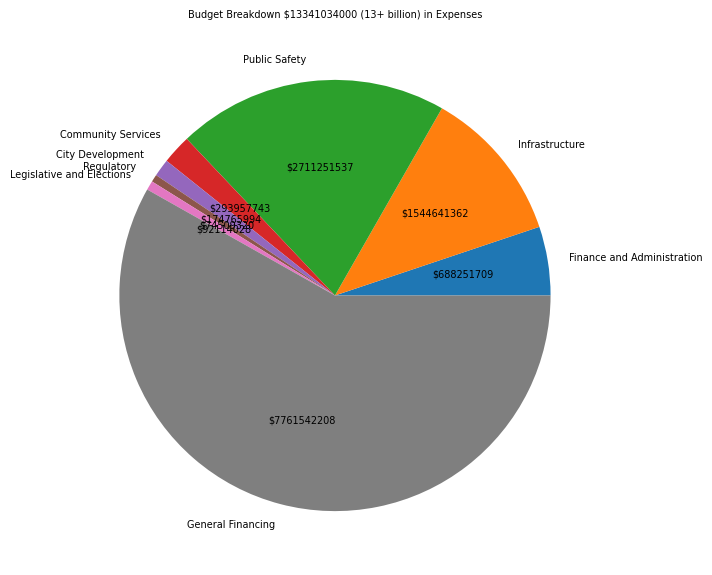
Demo 2 Exercise
# PACKAGE: DO NOT EDIT THIS CELL
%matplotlib inline
from ipywidgets import interact
import cv2, os
Show code cell source
def makepixelimage(folder, N):
directory = folder
# A data structure called a dictionary is used to store the image data and the dataframes we'll make from them.
imgs = {}
dfs = {}
# Specify the pixel image size
dsize = (N, N)
# This will iterate over every image in the directory given, read it into data, and create a
# dataframe for it. Both the image data and its corresponding dataframe are stored.
# Note that when being read into data, we interpret the image as grayscale.
pos = 0
for filename in os.listdir(directory):
f = os.path.join(directory, filename)
# checking if it is a file
if os.path.isfile(f):
imgs[pos] = cv2.imread(f, 0) # image data
imgs[pos] = cv2.resize(imgs[pos], dsize)
dfs[pos] = pd.DataFrame(imgs[pos]) # dataframe
pos += 1
return plt.imshow(imgs[0], cmap="gray")
makepixelimage("images", 16) #16x16 image
<matplotlib.image.AxesImage at 0x1874f628a90>
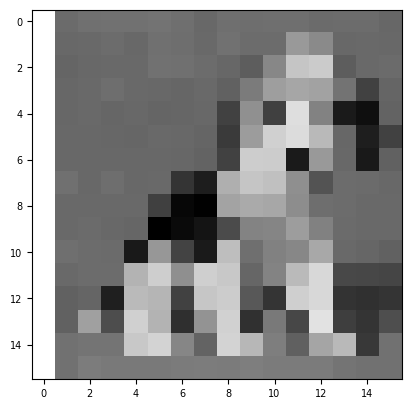
makepixelimage("images", 32) #32x32 image
<matplotlib.image.AxesImage at 0x1874f7f8550>
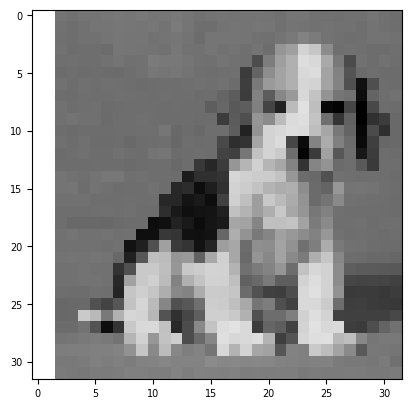
DEMO 3 Exercise
Show code cell source
import matplotlib.animation as animation
from matplotlib.animation import FuncAnimation
track_play=pd.read_excel('NFL_play.xlsx')
fig= plt.figure(figsize=(8,4))
temp=track_play[track_play["step"]==0]
xmin=temp["x_position"].min()
xmax=temp["x_position"].max()
ymin=temp["y_position"].min()
ymax=temp["y_position"].max()
plt.xlim(xmin-1,xmax+1)
plt.ylim(ymin-1,ymax+1)
for i in temp.index:
x=temp.loc[i,"x_position"]
y=temp.loc[i,"y_position"]
n=temp.loc[i,"nfl_player_id"]
p=temp.loc[i,"position"]
if temp.loc[i,"team"]=='home':
plt.text(x, y, p+str(n),color='b',size=5)
else:
plt.text(x, y, p+str(n),color='r',size=5)
plt.title("Play 1136 Step 0",size=10)
plt.show()
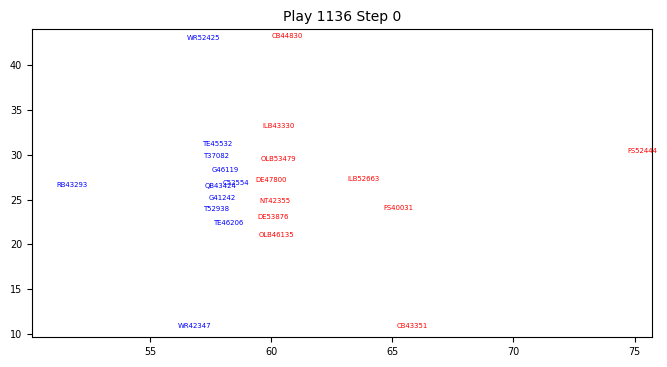
The wide receiver at the top is 52425 and cornerback is 44830.
Show code cell source
def playerpositions(data,play,player1,player2,position1,position2,step):
playdf=data[data["play_id"]==play]
playdf = playdf.sort_values(by = 'step')
playdf=playdf.reset_index(drop=True)
player1df=playdf[playdf["nfl_player_id"]==player1]
player1df = player1df.sort_values(by = 'step')
player1df=player1df.reset_index(drop=True)
player2df=playdf[playdf["nfl_player_id"]==player2]
player2df = player2df.sort_values(by = 'step')
player2df=player2df.reset_index(drop=True)
fig= plt.figure(figsize=(5,3))
plt.xlim(xmin-1,xmax+5)
plt.ylim(ymin-1,ymax+5)
x1=player1df.loc[step+108,"x_position"]
y1=player1df.loc[step+108,"y_position"]
x2=player2df.loc[step+108,"x_position"]
y2=player2df.loc[step+108,"y_position"]
plt.text(x1,y1,position1,color='b')
plt.text(x2,y2,position2,color='r')
plt.savefig(str(step)+'.png')
return
Show code cell source
frames=73
for step in np.arange(0,frames,1):
playerpositions(track_play,1136,52425,44830,'WR','CB',step)
Show code cell source
from PIL import Image
images = []
for n in range(frames):
exec('a'+str(n)+'=Image.open("'+str(n)+'.png")')
images.append(eval('a'+str(n)))
images[0].save('2player.gif',
save_all=True,
append_images=images[1:],
duration=5,
loop=0)
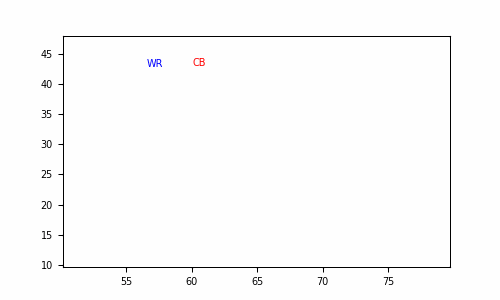
Demo 4 Exercise
Show code cell source
import wordcloud
#Define a function which counts the interesting words
def calculate_frequencies(textfile):
#list of punctuations
punctuations = '''!()-[]{};:'"\,<>./?@#$%^&*_~'''
#list of uninteresting words
uninteresting_words = ["AND","BY","IT","THE","THAT","A","IS","HAD","TO","NOT","BUT","FOR","OF","WHICH","IF","IN","ON","WERE","YE","THOU"]
# removes punctuation and uninteresting words
import re
fc1=str(textfile)
fc2= fc1.split(' ')
for i in range(len(fc2)):
fc2[i] = fc2[i].upper()
#Remove punctuations
fc3 = []
for s in fc2:
if not any([o in s for o in punctuations]):
fc3.append(s)
#Remove uninteresting words
fc4=[]
for s in fc3:
if not any([o in s for o in uninteresting_words]):
fc4.append(s)
fc5=[]
for s in fc4:
if not any([o.lower() in s for o in uninteresting_words]):
fc5.append(s)
while('' in fc5) :
fc5.remove('')
import collections
fc6 = collections.Counter(fc5)
#wordcloud
cloud = wordcloud.WordCloud( max_words = 15) #can adjust the number of words
cloud.generate_from_frequencies(fc6)
return cloud.to_array()
Show code cell source
import matplotlib.pyplot as plt
%matplotlib notebook
#Open the text file with the words to be plotted.
with open('twelvedays.txt','r') as file:
carol = file.readlines()
#make the wordcloud
carol = calculate_frequencies(carol)
plt.imshow(carol, interpolation = 'nearest')
plt.text(-5,70,"Merry Christmas!",color='r',size=40) #***TASK 2***Add Christmas! after Merry
plt.axis('off')
plt.savefig('card.png', bbox_inches='tight')
Demo 5 Exercise
Show code cell source
import numpy as np
def play(freq):
import numpy as np
from IPython.display import Audio #library used to create sounds
sampling_rate = 44100 # <- rate of sampling
t = np.linspace(0, 2, sampling_rate) # <- setup time values
sound_wave = np.sin(2 * np.pi * freq * t) # <- sine function formula
return Audio(sound_wave, rate=sampling_rate, autoplay=True) # play the generated sound
from IPython.display import Audio
rest=0
do=220
re=9/8*220
mi=5/4*220
fa=4/3*220
so=3/2*220
la=5/3*220
ti=15/8*220
do1=2*220
re1=2*9/8*220
mi1=2*5/4*220
fa1=2*4/3*220
so1=2*3/2*220
la1=2*5/3*220
ti1=2*15/8*220
do2=2*2*220
scale=[do,re,mi,fa,so,la,ti,do1]
def play(song):
song=np.array(song)
framerate = 44100
t = np.linspace(0, len(song) / 2, round(framerate * len(song) / 2))[:-1]
song_idx = np.floor(t * 2).astype(int)
data = np.sin(2 * np.pi * song[song_idx] * t)
return Audio(data, rate=framerate, autoplay=True)
jingle= [mi, rest,mi ,rest, mi, rest,rest, mi,rest, mi,rest,mi,rest,rest,mi, mi,so ,so, do,do, re,re, mi,mi]
play(jingle)

